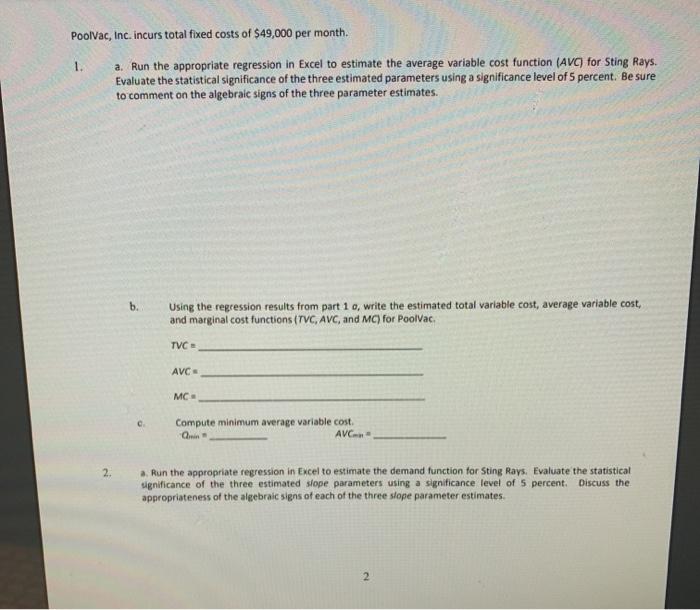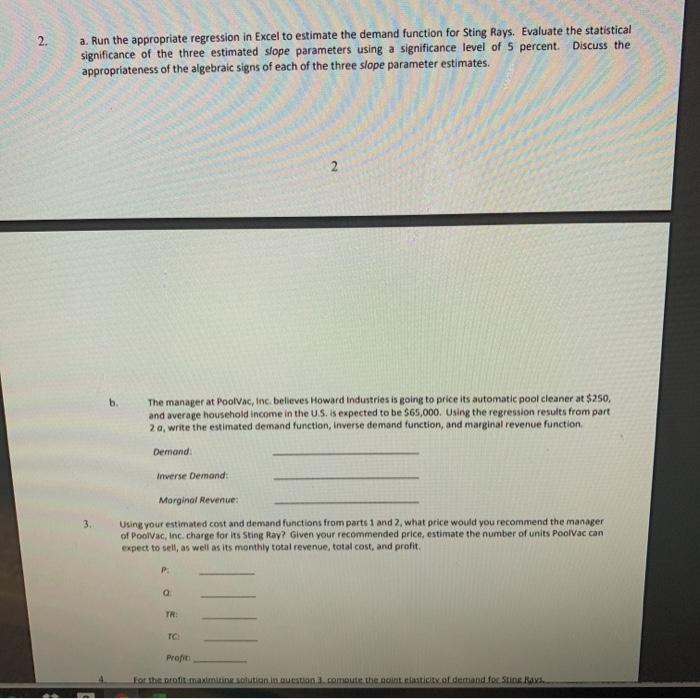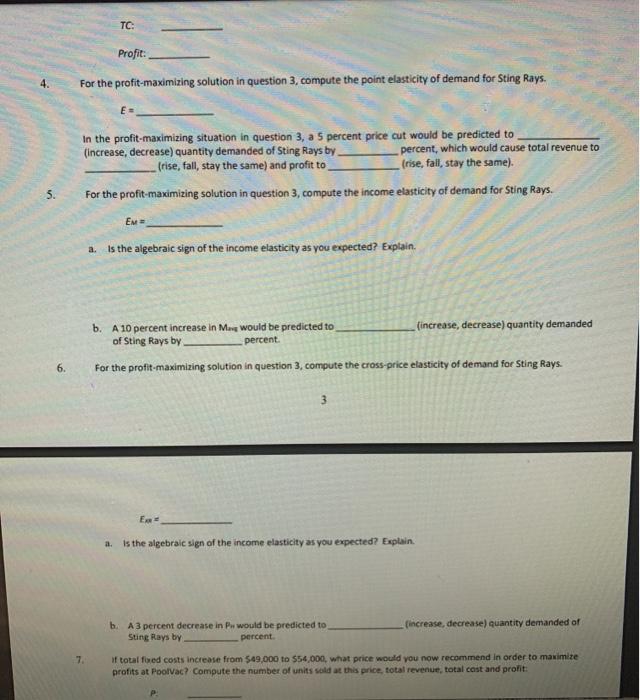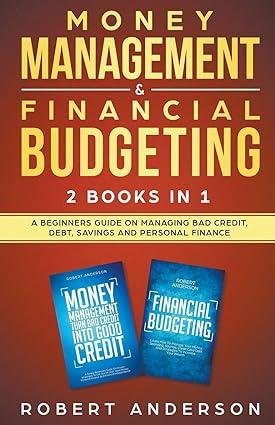Pricing and Production Decisions Poolvac, Inc. manufactures and sells a single product called the "Sting Ray," which is a patent-protected automatic cleaning device for swimming pools. Poolvac's Sting Ray accounts for 65 percent of total industry sales of automatic pool cleaners. Its closest competitor, Howard Industries, sells a competing pool cleaner that has captured about 18 percent of the market. Six other very small firms share the rest of the industry's sales. Using the last 26 months of production and cost data, Poolac wishes to estimate its unit variable costs using the following quadratic specification: AVC =0+bQ+cQ The monthly data on average variable cost (AVC), and the quantity of Sting Rays produced and sold each month (Q) are presented in the table below. Poolva also wishes to use its sales data for the last 26 months to estimate demand for its Sting Ray. Demand for Sting Rays is specified to be a linear function of its price (P), average income for households in the U.S. that have swimming pools (Ms), and the price of the competing pool cleaner sold by Howard Industries (P): Qd = d+ep+Mavg+ GPH The table below presents the last 26 months of data on the price charged for a Sting Ray (P), average income of households with pools (MAVG), and the price Howard Industries charged for its pool cleaner (PH): AVC Q PH 58115 MAVG 115 124 127 174 174 108 199 199 127 199 obs 1 2 3 4 5 6 7 8 9 10 11 12 13 108 111 107 114 119 120 111 113 110 110 108 122 132 199 199 199 249 P 279 279 304 304 304 304 304 304 329 354 354 329 329 329 329 1635 1652 1283 1319 1401 1366 1359 1300 1289 842 951 1226 1064 1080 1210 1296 1247 699 1106 79 125 845 58115 58115 56415 56415 56415 57965 57965 57965 57715 57715 57715 58365 58365 58365 59100 59100 59100 59715 59715 59715 60915 60915 60915 62465 14 329 15 16 17 18 19 249 249 224 224 224 224 249 249 249 249 374 122 145 20 21 22 329 379 354 479 479 379 354 324 324 324 158 122 133 129 110 120 374 24 25 26 1316 1364 1207 249 249 219 219 219 Poolvac, Inc. incurs total fixed costs of $49,000 per month. 1. a. Run the appropriate regression in Excel to estimate the average variable cost function (AVC) for Sting Rays. Evaluate the statistical significance of the three estimated parameters using a significance level of 5 percent. Be sure to comment on the algebraic signs of the three parameter estimates. b. Using the regression results from part 1 o, write the estimated total variable cost, average variable cost, and marginal cost functions (TVC, AVC, and MC) for Poolvac. TVC AVC Mcs 0 Compute minimum average variable cost Quin AVC 2. a. Run the appropriate regression in Excel to estimate the demand function for Sting Rays. Evaluate the statistical significance of the three estimated slope parameters using a significance level of 5 percent. Discuss the appropriateness of the algebraic signs of each of the three slope parameter estimates 2 2. a. Run the appropriate regression in Excel to estimate the demand function for Sting Rays. Evaluate the statistical significance of the three estimated slope parameters using a significance level of 5 percent. Discuss the appropriateness of the algebraic signs of each of the three slope parameter estimates. 2 b. The manager at Poolvac, Inc. believes Howard Industries is going to price its automatic pool cleaner at $250, and average household income in the US is expected to be $65,000. Using the regression results from part 2 a, write the estimated demand function, inverse demand function, and marginal revenue function Demand: Inverse Demand Morginal Revenue 3. Using your estimated cost and demand functions from parts 1 and 2, what price would you recommend the manager of PoolVac, Inc. charge for its Sting Ray? Given your recommended price, estimate the number of units PoolVac can expect to sell, as well as its monthly total revenue, total cost, and profit. P TR TC Propio For the profit maximiting solution in question compute the point clastity of demand for Stine Rays. TC. Profit: 4. For the profit-maximizing solution in question 3, compute the point elasticity of demand for Sting Rays. E= In the profit-maximizing situation in question 3, a 5 percent price cut would be predicted to (increase, decrease) quantity demanded of Sting Rays by percent, which would cause total revenue to (rise, fall, stay the same) and profit to (rise, fall, stay the same). For the profit-maximizing solution in question 3, compute the income elasticity of demand for Sting Rays. 3. EM Is the algebraic sign of the income elasticity as you expected? Explain. b. A 10 percent increase in Moe would be predicted to of Sting Rays by percent. (increase, decrease) quantity demanded 6. For the profit-maximizing solution in question 3, compute the cross-price elasticity of demand for Sting Rays. 3 E a. Is the algebraic sign of the income elasticity as you expected? Explain. b. A 3 percent decrease in Pw would be predicted to Sting Rays by percent increase, decrease) quantity demanded of if total fored costs increase from 549,000 to $54,000, what price would you now recommend in order to maximize profits at PoolVac? Compute the number of units sold at this price, total revenue, total cost and profit: For the profit-maximizing solution in question 3, compute the cross-price elasticity of demand for Sting Rays. 3 Ex a. Is the algebraic sign of the income elasticity as you expected? Explain. b. A 3 percent decrease in Pu would be predicted to (increase, decrease) quantity demanded of Sting Rays by percent of total fixed costs increase from $49,000 to $54,000, what price would you now recommend in order to maximize profits at PoolVac? Compute the number of units sold at this price, total revenue, total cost and profit: 7. P Q TR: TC Profit 8. If the manager of Poolvac wanted to maximize total revenue instead of profit (a bad idea), the manager would charge a price of $ At this price, PoolVac's profit would be $ which 6 (higher than, lower than the same as the profit in question 3. Pricing and Production Decisions Poolvac, Inc. manufactures and sells a single product called the "Sting Ray," which is a patent-protected automatic cleaning device for swimming pools. Poolvac's Sting Ray accounts for 65 percent of total industry sales of automatic pool cleaners. Its closest competitor, Howard Industries, sells a competing pool cleaner that has captured about 18 percent of the market. Six other very small firms share the rest of the industry's sales. Using the last 26 months of production and cost data, Poolac wishes to estimate its unit variable costs using the following quadratic specification: AVC =0+bQ+cQ The monthly data on average variable cost (AVC), and the quantity of Sting Rays produced and sold each month (Q) are presented in the table below. Poolva also wishes to use its sales data for the last 26 months to estimate demand for its Sting Ray. Demand for Sting Rays is specified to be a linear function of its price (P), average income for households in the U.S. that have swimming pools (Ms), and the price of the competing pool cleaner sold by Howard Industries (P): Qd = d+ep+Mavg+ GPH The table below presents the last 26 months of data on the price charged for a Sting Ray (P), average income of households with pools (MAVG), and the price Howard Industries charged for its pool cleaner (PH): AVC Q PH 58115 MAVG 115 124 127 174 174 108 199 199 127 199 obs 1 2 3 4 5 6 7 8 9 10 11 12 13 108 111 107 114 119 120 111 113 110 110 108 122 132 199 199 199 249 P 279 279 304 304 304 304 304 304 329 354 354 329 329 329 329 1635 1652 1283 1319 1401 1366 1359 1300 1289 842 951 1226 1064 1080 1210 1296 1247 699 1106 79 125 845 58115 58115 56415 56415 56415 57965 57965 57965 57715 57715 57715 58365 58365 58365 59100 59100 59100 59715 59715 59715 60915 60915 60915 62465 14 329 15 16 17 18 19 249 249 224 224 224 224 249 249 249 249 374 122 145 20 21 22 329 379 354 479 479 379 354 324 324 324 158 122 133 129 110 120 374 24 25 26 1316 1364 1207 249 249 219 219 219 Poolvac, Inc. incurs total fixed costs of $49,000 per month. 1. a. Run the appropriate regression in Excel to estimate the average variable cost function (AVC) for Sting Rays. Evaluate the statistical significance of the three estimated parameters using a significance level of 5 percent. Be sure to comment on the algebraic signs of the three parameter estimates. b. Using the regression results from part 1 o, write the estimated total variable cost, average variable cost, and marginal cost functions (TVC, AVC, and MC) for Poolvac. TVC AVC Mcs 0 Compute minimum average variable cost Quin AVC 2. a. Run the appropriate regression in Excel to estimate the demand function for Sting Rays. Evaluate the statistical significance of the three estimated slope parameters using a significance level of 5 percent. Discuss the appropriateness of the algebraic signs of each of the three slope parameter estimates 2 2. a. Run the appropriate regression in Excel to estimate the demand function for Sting Rays. Evaluate the statistical significance of the three estimated slope parameters using a significance level of 5 percent. Discuss the appropriateness of the algebraic signs of each of the three slope parameter estimates. 2 b. The manager at Poolvac, Inc. believes Howard Industries is going to price its automatic pool cleaner at $250, and average household income in the US is expected to be $65,000. Using the regression results from part 2 a, write the estimated demand function, inverse demand function, and marginal revenue function Demand: Inverse Demand Morginal Revenue 3. Using your estimated cost and demand functions from parts 1 and 2, what price would you recommend the manager of PoolVac, Inc. charge for its Sting Ray? Given your recommended price, estimate the number of units PoolVac can expect to sell, as well as its monthly total revenue, total cost, and profit. P TR TC Propio For the profit maximiting solution in question compute the point clastity of demand for Stine Rays. TC. Profit: 4. For the profit-maximizing solution in question 3, compute the point elasticity of demand for Sting Rays. E= In the profit-maximizing situation in question 3, a 5 percent price cut would be predicted to (increase, decrease) quantity demanded of Sting Rays by percent, which would cause total revenue to (rise, fall, stay the same) and profit to (rise, fall, stay the same). For the profit-maximizing solution in question 3, compute the income elasticity of demand for Sting Rays. 3. EM Is the algebraic sign of the income elasticity as you expected? Explain. b. A 10 percent increase in Moe would be predicted to of Sting Rays by percent. (increase, decrease) quantity demanded 6. For the profit-maximizing solution in question 3, compute the cross-price elasticity of demand for Sting Rays. 3 E a. Is the algebraic sign of the income elasticity as you expected? Explain. b. A 3 percent decrease in Pw would be predicted to Sting Rays by percent increase, decrease) quantity demanded of if total fored costs increase from 549,000 to $54,000, what price would you now recommend in order to maximize profits at PoolVac? Compute the number of units sold at this price, total revenue, total cost and profit: For the profit-maximizing solution in question 3, compute the cross-price elasticity of demand for Sting Rays. 3 Ex a. Is the algebraic sign of the income elasticity as you expected? Explain. b. A 3 percent decrease in Pu would be predicted to (increase, decrease) quantity demanded of Sting Rays by percent of total fixed costs increase from $49,000 to $54,000, what price would you now recommend in order to maximize profits at PoolVac? Compute the number of units sold at this price, total revenue, total cost and profit: 7. P Q TR: TC Profit 8. If the manager of Poolvac wanted to maximize total revenue instead of profit (a bad idea), the manager would charge a price of $ At this price, PoolVac's profit would be $ which 6 (higher than, lower than the same as the profit in question 3











